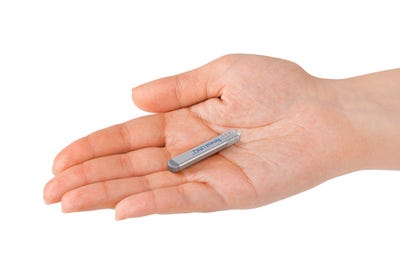March 15, 2017
After Medtronic released its Reveal Linq insertable cardiac monitor in 2014, the company immediately wanted to make the device better. This week a Medtronic manager told Qmed & MDDI about the aggressive timeline the R&D team followed to deliver a more accurate version of the device, which just received FDA clearance.
Amanda Pedersen

Medtronic launched Reveal Linq in 2014, which was lauded as the smallest insertable cardiac monitor on the market. Now the company has FDA clearance for a new version of the device, Reveal Linq with TruRhythm Detection, designed to more accurately identify abnormal heartbeats compared to its predecessor.
Medtronic may be known as one of the giants of the medtech industry, but the company won't be caught sitting on its laurels anytime soon. After launching the Reveal Linq insertable cardiac monitor (ICM) in 2014, the company immediately started analyzing ECG data to identify opportunities to improve accuracy, said Chris Landon, VP and general manager of diagnostics at Medtronic.
Learn about emerging sensor technology, healthcare IoT, and product development at BIOMEDevice Boston, May 3-4, 2017. |
Those efforts paid off. This week the Dublin-based company won FDA clearance for Reveal Linq ICM with TruRhythm Detection. The new iteration of the device is designed to more accurately identify abnormal heartbeats compared to its predecessor.
"The timeline for development was very aggressive as we wanted to bring these enhancements to physicians as quickly as possible," Landon told Qmed when asked what the biggest challenge was for making the enhancements.
"After in-depth analysis, the R&D team mobilized to develop and test new algorithms and design clinical evidence to support their performance," Landon said.
Those new algorithms resulted in 95% fewer false bradycardia (slow heartbeat) episodes and a 47% reduction in false pause episodes (brief absences of cardiac activity) compared to the original device. The new version also includes a self-learning atrial fibrillation (AF) algorithm, designed to learn and adapt to a patient's heart rhythm over time.
AF episodes are more likely to trigger false positives with ICMs, Medtronic noted, and the new algorithms reduce false detections by 49% compared to the earlier version of the Reveal Linq ICM.
"ICMs help physicians find answers for patients at risk for cardiac arrhythmias to better manage a range of patient populations," said James Allred, an electrophysiologist at Cone Health Medical Group Heartcare in Greensboro, NC. "The enhancements with the Reveal Linq ICM with TruRhythm Detection make it smarter by streamlining device data review so physicians can make decisions more accurately and quickly for patients."
The device is designed to allow continuous and wireless heart monitoring for up to three years. It's about a third the size of a AAA battery and is placed just beneath the skin in the upper left side of the chest.
The device is designed to communicate wirelessly with a patient bedside monitor that uploads device data to the Medtronic CareLink network. It is MR-Conditional, so patients can undergo MRI if needed.
Nina Goodheart, VP and general manager of Medtronic's patient monitoring and diagnostics business, said the company worked with hundreds of clinicians and analyzed more than 50,000 ECGs in order to pinpoint how we to redesign the algorithms to improve detection specificity, without compromising sensitivity.
Amanda Pedersen is Qmed's news editor. Contact her at [email protected].
About the Author(s)
You May Also Like


